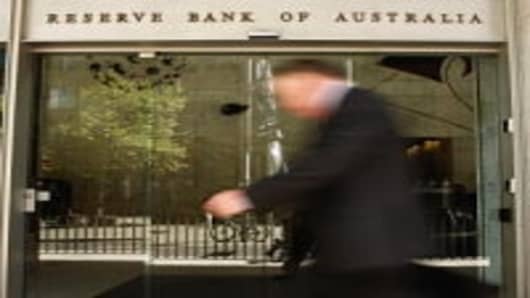Easing inflation and weak economic data out of key export destination China, is unlikely to push Australia’s central bank to cut interest rates at its next meeting on Tuesday.
The Reserve Bank of Australia is widely expected to hold interest rates at 3.5 percent after it cut rates by a total of 75 basis points at its two previous meetings.
On Monday, a private gauge of Australian inflation showed that consumer prices had dipped 0.2 percent in June taking the annual rate down to 1.6 percent, well under the RBA’s target range of 2-3 percent. While factory activity in China – the country’s biggest trading partner – shrank at its fastest pace in seven months in June.
However, economists say improving economic data out of Australia make a case for the RBA to stand pat on rates.
“The RBA is not rushing to cut rates again in July, especially as unemployment remains low and GDP is back growing at an above-trend rate. A sharp deterioration in the European outlook may yet force a cut, but our central case is that rates remain steady at 3.5 percent,” Kieran Davies, Economist at Barclays, said in a note on Monday.
Market pricing currently shows a 22 percent chance of a 25 basis point cut, down from almost 90 percent earlier in June, he added.
When the central bank cut rates last month it cited weaker outlook abroad and modest domestic growth. However, the country’s growth data, released a day later on June 6, far outpaced expectations – with the economy expanding at its fastest pace in over four years in the first quarter.
Michala Marcussen, Global Head of Economics at Société Générale, says with the Australian dollar off its peak, it further reduces pressure for an additional rate cut at the moment. Weakness in the currency – which has declined 5 percent against the U.S. dollar in the last 12 months – makes Australian-made goods more competitive, providing a boost to the export sector.
Davies and Marcussen, however, believe that the RBA will likely retain an easing bias given the uncertainty over Europe.
Central banks in the West, including the European Central Bank (ECB) and Bank of England (BOE), on the other hand, are expected to adopt a dovish stance at their policy meetings this week.
The ECB, which meets on June 5, is forecast to cut rates to a record low of 0.75 percent from 1 percent. While, the BOE is seen expanding its asset-purchase program by 50 billion pounds as Britain's economic growth outlook deteriorates and a lower inflation rate gives the central bank room to offer further support.



